| 登録情報 | データベース: PDB / ID: 4fkd
|
|---|
| タイトル | Identification of the Activator Binding Residues in the Second Cysteine-Rich Regulatory Domain of Protein Kinase C Theta |
|---|
 要素 要素 | Protein kinase C theta type |
|---|
 キーワード キーワード | TRANSFERASE / PKC theta / second cysteine rich regulatory domain / activator binding site / zinc finger / Kinase |
|---|
| 機能・相同性 |  機能・相同性情報 機能・相同性情報
Netrin-1 signaling / positive regulation of T-helper 2 cell activation / Apoptotic cleavage of cellular proteins / Effects of PIP2 hydrolysis / RAS processing / protein kinase C / FCERI mediated NF-kB activation / diacylglycerol-dependent serine/threonine kinase activity / Downstream TCR signaling / regulation of platelet aggregation ...Netrin-1 signaling / positive regulation of T-helper 2 cell activation / Apoptotic cleavage of cellular proteins / Effects of PIP2 hydrolysis / RAS processing / protein kinase C / FCERI mediated NF-kB activation / diacylglycerol-dependent serine/threonine kinase activity / Downstream TCR signaling / regulation of platelet aggregation / CD4-positive, alpha-beta T cell proliferation / negative regulation of T cell apoptotic process / positive regulation of CD4-positive, alpha-beta T cell proliferation / positive regulation of T-helper 17 type immune response / aggresome / positive regulation of interleukin-4 production / positive regulation of telomere maintenance / positive regulation of interleukin-17 production / membrane protein ectodomain proteolysis / immunological synapse / positive regulation of interleukin-2 production / negative regulation of insulin receptor signaling pathway / T cell activation / cell chemotaxis / positive regulation of NF-kappaB transcription factor activity / positive regulation of T cell activation / centriolar satellite / intracellular signal transduction / inflammatory response / protein serine kinase activity / regulation of DNA-templated transcription / zinc ion binding / ATP binding / plasma membrane / cytoplasm類似検索 - 分子機能 Protein kinase C, theta / Novel protein kinase C theta, catalytic domain / Protein kinase C delta/epsilon/eta/theta, C2 domain / Protein kinase C, delta/epsilon/eta/theta types / Wheat Germ Agglutinin (Isolectin 2); domain 1 - #20 / Protein kinase, C-terminal / Protein kinase C terminal domain / Wheat Germ Agglutinin (Isolectin 2); domain 1 / Diacylglycerol/phorbol-ester binding / Phorbol esters/diacylglycerol binding domain (C1 domain) ...Protein kinase C, theta / Novel protein kinase C theta, catalytic domain / Protein kinase C delta/epsilon/eta/theta, C2 domain / Protein kinase C, delta/epsilon/eta/theta types / Wheat Germ Agglutinin (Isolectin 2); domain 1 - #20 / Protein kinase, C-terminal / Protein kinase C terminal domain / Wheat Germ Agglutinin (Isolectin 2); domain 1 / Diacylglycerol/phorbol-ester binding / Phorbol esters/diacylglycerol binding domain (C1 domain) / Zinc finger phorbol-ester/DAG-type signature. / Zinc finger phorbol-ester/DAG-type profile. / Protein kinase C conserved region 1 (C1) domains (Cysteine-rich domains) / Protein kinase C-like, phorbol ester/diacylglycerol-binding domain / C2 domain / C2 domain profile. / C1-like domain superfamily / Extension to Ser/Thr-type protein kinases / AGC-kinase, C-terminal / AGC-kinase C-terminal domain profile. / C2 domain superfamily / Serine/threonine-protein kinase, active site / Serine/Threonine protein kinases active-site signature. / Protein kinase domain / Serine/Threonine protein kinases, catalytic domain / Protein kinase, ATP binding site / Protein kinases ATP-binding region signature. / Protein kinase domain profile. / Protein kinase domain / Protein kinase-like domain superfamily / 2-Layer Sandwich / Alpha Beta類似検索 - ドメイン・相同性 |
|---|
| 生物種 |   Mus musculus (ハツカネズミ) Mus musculus (ハツカネズミ) |
|---|
| 手法 |  X線回折 / X線回折 /  分子置換 / 解像度: 1.633 Å 分子置換 / 解像度: 1.633 Å |
|---|
 データ登録者 データ登録者 | Rahman, G.M. / Shanker, S. / Lewin, N.E. / Prasad, B.V.V. / Blumberg, P.M. / Das, J. |
|---|
 引用 引用 |  ジャーナル: Biochem.J. / 年: 2013 ジャーナル: Biochem.J. / 年: 2013
タイトル: Identification of the Activator Binding Residues in the Second Cysteine-Rich Regulatory Domain of Protein Kinase C Theta.
著者: Rahman, G.M. / Shanker, S. / Lewin, N.E. / Kedei, N. / Hill, C.S. / Prasad, B.V. / Blumberg, P.M. / Das, J. |
|---|
| 履歴 | | 登録 | 2012年6月13日 | 登録サイト: RCSB / 処理サイト: RCSB |
|---|
| 改定 1.0 | 2013年1月23日 | Provider: repository / タイプ: Initial release |
|---|
| 改定 1.1 | 2013年6月19日 | Group: Database references |
|---|
| 改定 1.2 | 2024年2月28日 | Group: Data collection / Database references / Derived calculations
カテゴリ: chem_comp_atom / chem_comp_bond ...chem_comp_atom / chem_comp_bond / database_2 / pdbx_struct_conn_angle / struct_conn / struct_ref_seq_dif / struct_site
Item: _database_2.pdbx_DOI / _database_2.pdbx_database_accession ..._database_2.pdbx_DOI / _database_2.pdbx_database_accession / _pdbx_struct_conn_angle.ptnr1_auth_comp_id / _pdbx_struct_conn_angle.ptnr1_auth_seq_id / _pdbx_struct_conn_angle.ptnr1_label_atom_id / _pdbx_struct_conn_angle.ptnr1_label_comp_id / _pdbx_struct_conn_angle.ptnr1_label_seq_id / _pdbx_struct_conn_angle.ptnr2_auth_seq_id / _pdbx_struct_conn_angle.ptnr2_label_asym_id / _pdbx_struct_conn_angle.ptnr3_auth_comp_id / _pdbx_struct_conn_angle.ptnr3_auth_seq_id / _pdbx_struct_conn_angle.ptnr3_label_atom_id / _pdbx_struct_conn_angle.ptnr3_label_comp_id / _pdbx_struct_conn_angle.ptnr3_label_seq_id / _pdbx_struct_conn_angle.value / _struct_conn.pdbx_dist_value / _struct_conn.ptnr1_auth_comp_id / _struct_conn.ptnr1_auth_seq_id / _struct_conn.ptnr1_label_atom_id / _struct_conn.ptnr1_label_comp_id / _struct_conn.ptnr1_label_seq_id / _struct_conn.ptnr2_auth_seq_id / _struct_conn.ptnr2_label_asym_id / _struct_ref_seq_dif.details / _struct_site.pdbx_auth_asym_id / _struct_site.pdbx_auth_comp_id / _struct_site.pdbx_auth_seq_id |
|---|
|
|---|
 データを開く
データを開く 基本情報
基本情報 要素
要素 キーワード
キーワード 機能・相同性情報
機能・相同性情報
 X線回折 /
X線回折 /  分子置換 / 解像度: 1.633 Å
分子置換 / 解像度: 1.633 Å  データ登録者
データ登録者 引用
引用 ジャーナル: Biochem.J. / 年: 2013
ジャーナル: Biochem.J. / 年: 2013 構造の表示
構造の表示 Molmil
Molmil Jmol/JSmol
Jmol/JSmol ダウンロードとリンク
ダウンロードとリンク ダウンロード
ダウンロード 4fkd.cif.gz
4fkd.cif.gz PDBx/mmCIF形式
PDBx/mmCIF形式 pdb4fkd.ent.gz
pdb4fkd.ent.gz PDB形式
PDB形式 4fkd.json.gz
4fkd.json.gz PDBx/mmJSON形式
PDBx/mmJSON形式 その他のダウンロード
その他のダウンロード 4fkd_validation.pdf.gz
4fkd_validation.pdf.gz wwPDB検証レポート
wwPDB検証レポート 4fkd_full_validation.pdf.gz
4fkd_full_validation.pdf.gz 4fkd_validation.xml.gz
4fkd_validation.xml.gz 4fkd_validation.cif.gz
4fkd_validation.cif.gz https://data.pdbj.org/pub/pdb/validation_reports/fk/4fkd
https://data.pdbj.org/pub/pdb/validation_reports/fk/4fkd ftp://data.pdbj.org/pub/pdb/validation_reports/fk/4fkd
ftp://data.pdbj.org/pub/pdb/validation_reports/fk/4fkd リンク
リンク 集合体
集合体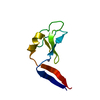
 要素
要素

 X線回折 / 使用した結晶の数: 1
X線回折 / 使用した結晶の数: 1  試料調製
試料調製 回転陽極 / タイプ: RIGAKU FR-E+ SUPERBRIGHT / 波長: 1.54178 Å
回転陽極 / タイプ: RIGAKU FR-E+ SUPERBRIGHT / 波長: 1.54178 Å 解析
解析 分子置換 / 解像度: 1.633→28.514 Å / SU ML: 0.17 / σ(F): 1.38 / 位相誤差: 24.7 / 立体化学のターゲット値: ML
分子置換 / 解像度: 1.633→28.514 Å / SU ML: 0.17 / σ(F): 1.38 / 位相誤差: 24.7 / 立体化学のターゲット値: ML ムービー
ムービー コントローラー
コントローラー




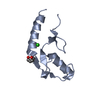
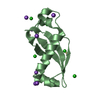


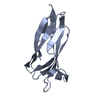

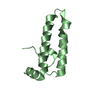
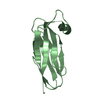

 PDBj
PDBj














